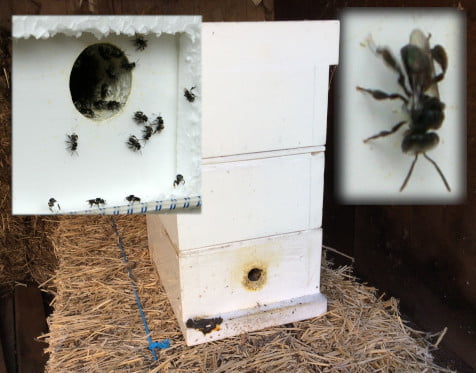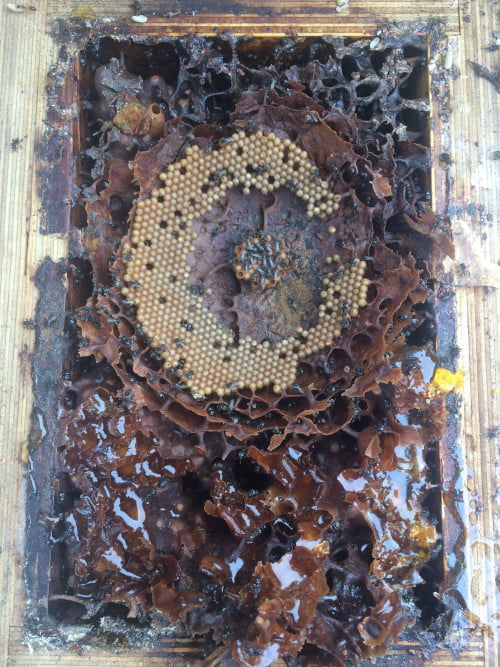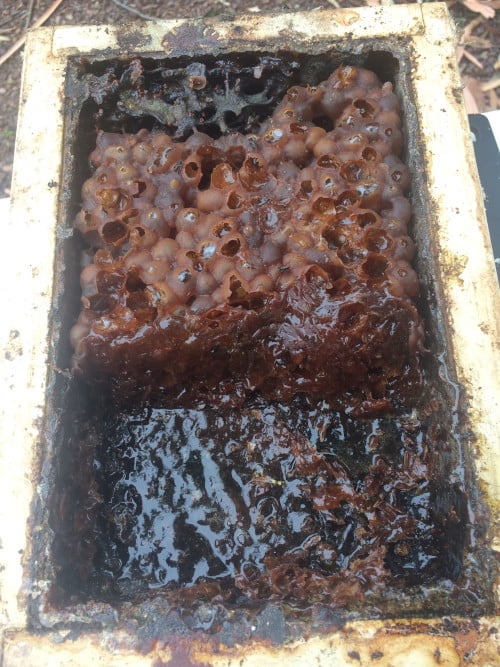Backyard Beekeeping
By Neil Ritchie, Brandy Hill.
Do you have mixed feelings about bees, like me? Well you know they are important for pollination and give us honey – but their sting is painful and for some, life threatening.

I once thought beekeepers were crazy, but then I became one after my daughter wanted a pet snake – or bees! Bees seemed like the better option so a friend set up a hive for her, but then she left home for a city flat, leaving the bees to my care! After discovering the joys of beekeeping and establishing my apiary, my daughter’s colleague split a native bee colony for me. My bee collection has since grown to 6 honey bee hives and 6 native bee colonies.
I am a member of the Hunter Valley Amateur Beekeepers Association (HVABA) based in Heatherbrae, and we have become aware of four 21st century revolutions in beekeeping which have been playing out. All have dramatically changed the nature of beekeeping. I’ll mention them all and focus on the last one.
1. Have you noticed fewer, or no bees in your garden? Around 20 years ago, the African Small Hive Beetle (SHB) was introduced to Australia and is now widespread in eastern states. SHB likely causes most colony failures – luckily we don’t have the parasitic mite Varroa in Australia.
2. Climate: the seasons just aren’t behaving the way they used to – and this affects all natural systems. Bees are particularly sensitive to temperature changes.
3. Flow hives are those where honey is extracted without disturbing the bees (nor do you get stung as often).
4. There has been an explosion of interest in native bees amongst the Australian public as well as a better understanding of the importance of all pollinators. Amateur beekeeping is on the rise.
Native Stingless Bee Colonies
I believe that revolution #4 is an indirect result of the other revolutions. Bees and koalas have become the focus of our awareness of the fragility of our environment and the threats to it. The development of techniques has made it possible for people to keep native stingless bees in their backyard or balcony. This means we can all play an important role in their preservation.
Not everyone who wants to keep honey bees can. Even with a flow hive, the heavy top honey super has to be lifted off and the brood managed for disease and pest control, re-queening, swarm prevention and frame replacement. That requires lifting 25kg or more, good eyesight and a tolerance of stings.
The native variety don’t sting, the hive boxes are small weighing only 15kg and, best of all, they can be left to look after themselves – for decades. The boxes only need to be handled if you want to collect sugarbag honey or clone off another colony.

All continents, except Antarctica, have thousands of species of native bees. Most are unique to each continent. The European honey bee (Apis mellifera) is one of the few species that has spread worldwide. Australia has almost 2000 known species of native bees. Most are solitary and raise their young in a burrow of their own. We are fortunate to have Blue Banded bees foraging in our garden and burrowing in our plant pots. Only a few native species form colonies where, like honey bees, a queen lays all the eggs and her many workers undertake specialised tasks.
The native stingless bee or Sugarbag bee (Tetragonula carbonaria) is one of those and it thrives here in Port Stephens. It prefers warmer coastal areas and so its distribution does not extend much beyond Sydney. While the Langstroth beehive is the standard design for honey bees, the Original Australia Tetragonula Hive (OATH) is the standard for stingless bees. There are various other designs for both types of bees – but only native bees can be kept in a hollow tree trunk or branch. Now that is natural beekeeping!
I was lucky to be given a section of tree trunk with a colony of stingless bees years ago, and they have lived there with zero maintenance ever since. Unfortunately, honey cannot be harvested from a log colony.
Until recently, the OATH design favoured a single honey superstructure frame (known as a super). After reading about a Queensland innovator experimenting successfully with a series of 2-4 shallower supers, I have built sets for my 5 OATH boxes. The bees create a single layer of sugarbag honey pots rather than a jumbled amorphous block. Whereas honey bees have a vertical comb with near horizontal honey cells, Tetragonula have horizontal planes of waxy vertical pots.
The brood is raised in an endless spiral of comb in the lower section. (See centre photo). When the brood spiral reaches the baffle in the top and the brood has hatched from the lower section, they dismantle that and take it outside, then build new brood comb. That is why a colony can live in the one hollow or OATH box almost indefinitely.
The single layer of pots in the ‘series supers’ also reveals any pollen pots. These can be removed before spiking and draining or cutting out and pressing the honey from the pots. The pollen contaminates the honey making it cloudy and the yeasts promote fermentation, which occurs because of the higher moisture content compared to honey bee honey.

Interestingly, the bees maintain a ‘bee-space’ gap between the honey pots and the walls, ceiling and floor of the supers. They are more strongly attached to the ceiling than the floor. When a super is prised off the OATH hive, the honey pots always stay within the lid. (See bottom photo).
I am now experimenting with double-sided supers, where the supers separate in the middle of the honey pots, so that a hot knife can be used to uncap the bottoms of the pots to extract the honey. More of the pot structure will be left intact so that the bees will have less rebuilding to do. At least that’s the theory – hopefully to be proven this summer!
An OATH hive may produce only a kilogram or so of honey per year, compared to 100 – 200kg for honey bees, but it makes up for this by being delicious! It takes on the flavours of the tree saps and propolis1 that native bees use to make the pots, making it taste like the essence of our Australian bush. Like wine develops flavours from wooden casks, sugarbag honey is flavoured by the pots. The last photo is of the underside of a standard OATH super after a block of honey pots has been removed.
I hope you’ve been inspired to start a new hobby – I assure you will find not only personal enjoyment from keeping native bees but you will be helping to secure the future for this special Australian species. If you’d like to learn more about beekeeping, please join the Hunter Valley Amateur Beekeepers Club. Established in 1964, we now have over 300 members with many experienced beekeepers of all ages. We encourage the protection and creation of native bee habitat. When possible we meet monthly at the Hunter Botanic Gardens where we have several native bee hives.
—————————————————
1 As well as honey, bees also produce a compound called propolis from tree sap. Combined with their own beeswax, they create this sticky, greenish-brown product used as a coating to build their hives.Although research is limited, propolis is thought to be an anti-inflammatory and provide protection from certain bacteria, viruses, and fungi.
Useful links:
- Hunter Valley Amateur Beekeepers Association – Native Bees
- EcoNetwork Port Stephens – EcoPollinators
- Native bees make delicious honey
Useful videos:
